
Dactylorhiza: planting, growing, and care
Contents
Dactylorhiza in a few words
- Dactylorhiza are very beautiful orchids with pink or purple flowers, gathered in dense spikes.
- Their unique flowering is admired, with petals adorned with violet or purple patterns.
- Their leaves are sometimes attractively spotted with brown-purple macules.
- They bring a very natural and wild style to the garden!
- Grow them in a partially shaded rockery, a meadow, or on the banks of a pond.
- They have the advantage of being very hardy, tolerating temperatures of around -20°C.
The word from our expert
Dactylorhiza are hardy orchids with tuberous roots, which grow naturally in France and can be cultivated in the garden. Between April and July, they produce very beautiful floral spikes, cylindrical and dense, composed of numerous flowers, typically pink, mauve, or purple, with petals attractively maculate. Some species, such as the Dactylorhiza maculata, also feature highly original foliage, green with purple-spotted markings. After flowering, their foliage naturally withers, and they enter dormancy, reappearing the following spring.
In the garden, they thrive in sun or partial shade, in fresh to moist, well-draining, and slightly acidic soil (though this varies by species; the Dactylorhiza fuchsii prefers calcareous soils). They are perfect for a naturalistic garden, a flowering meadow, a partially shaded rockery, or a bed alongside delicate and airy flowers. Some species, such as the Dactylorhiza praetermissa, will thrive on the banks of a pond, where they can accompany other orchids like Epipactis gigantea, ferns, Euphorbia palustris, Iris pseudacorus, and Japanese primroses.
Discover these splendid orchids and all our tips for successful cultivation!
Botany
Botanical data
- Latin name Dactylorhiza sp.
- Family Orchidaceae
- Common name orchis, dactylorhiza
- Flowering between April and July
- Height between 30 and 50 cm
- Sun exposure sun or partial shade
- Soil type moist to wet, rather acidic
- Hardiness very good, between –20 and –25 °C
Dactylorhiza are beautiful terrestrial and tuberous orchids comprising around 80 species. They have a wide distribution in the temperate regions of the northern hemisphere: they can be found in Europe, Asia, North Africa, and North America. Around twenty species grow naturally in France, mainly in wetlands and acidic soils, such as wet meadows, marshes, peat bogs, and ditches, but they can also be found in drier and calcareous soils. They are sometimes seen along paths, on embankments, and at the edges of forests. Some species grow in alpine pastures in the mountains, such as the Elder-flowered Orchid, Dactylorhiza sambucina. Dactylorhiza have the advantage of being very hardy, tolerating temperatures as low as –20 to –25 °C, or even lower; they can thus be cultivated even in regions with cold climates.
The name Dactylorhiza comes from the Greek daktylos: finger and rhiza: root, as this orchid has digitate tubers, resembling fingers.
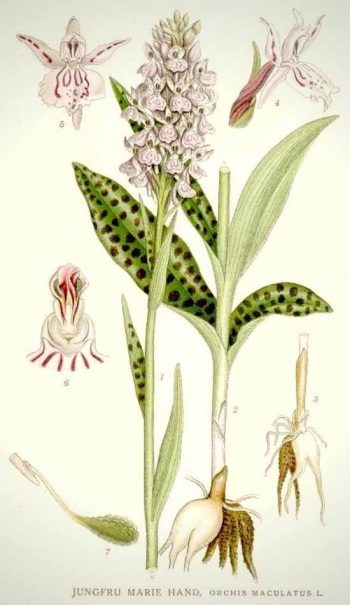
Dactylorhiza maculata: Botanical illustration
The different species of Dactylorhiza hybridise easily with each other; thus, the boundaries between species are narrow, and there are many subspecies. The flowers can also vary in colour within the same species, depending on factors such as soil type, cross-breeding, or genetic variations. This makes their identification challenging.
Dactylorhiza generally flower between April and July. They produce dense, upright clusters, conical or cylindrical in shape, composed of numerous small flowers, which bloom progressively from the bottom to the top of the inflorescence. Each cluster typically contains between 25 and 50 flowers, measuring 5 to 15 cm in length. They are borne on a stiff, thick, and robust flowering stem, reaching between 30 and 60 cm in height. Like all orchid flowers, they have a complex shape and structure. They consist of a large lower petal called the labellum, slightly trilobed, and two upper petals forming the galea. The labellum is usually adorned with purple or maroon patterns, adding detail and contrast to the flowering. These petals are surrounded by three sepals, two of which are lateral and upright. The flower also has a spur (an extension of the labellum), which contains the nectar that attracts pollinating insects. The stamens and pistil are fused to form a central column called the gynostemium. The pollen grains are unique in being grouped into sacs called pollinia.
The flowers of Dactylorhiza are most often purple, pink, or mauve, but can also be red, white, or yellow, depending on the species, or even green in the case of Dactylorhiza viridis. Sometimes, the same species can produce flowers of different colours: for example, the Elder-flowered Orchid, Dactylorhiza sambucina, naturally blooms in purple or pale yellow, with both forms sometimes coexisting in the same location.

The flowering of Dactylorhiza majalis (photo: Bjorn S.), Dactylorhiza maculata, Dactylorhiza praetermissa (photo: Hans Hillewaert), and Dactylorhiza fuchsii (photo: Bernd Haynold)
Dactylorhiza have lanceolate green leaves, sometimes beautifully spotted with purple, as in Dactylorhiza maculata. They measure between 10 and 20 cm in length and are rather thick and fleshy. The leaves at the top of the stem are smaller than the basal leaves.
After flowering, during the summer, the foliage gradually yellows and withers, and the plant enters dormancy. It is important not to cut the leaves before they are completely dry, as they allow the plant to replenish its reserves, stored in the tuber, enabling it to grow and flower again the following spring.
Dactylorhiza have thickened, digitate tubers (resembling fingers). These allow them to store water and minerals to withstand drought and survive winter dormancy in the soil.
After flowering, Dactylorhiza produces capsules containing numerous tiny seeds. These are so small that they resemble dust and are easily dispersed by the wind, allowing the plant to colonise new areas. Unlike most seeds, they contain no nutrient reserves and therefore require, during germination, to associate with a fungus that will provide the necessary nutrients for their growth. This makes sowing orchids particularly challenging.

The foliage of Dactylorhiza maculata (photo: Enrico Blasutto), its fruits (capsules containing the seeds), and its digitate tubers
The main varieties of Dactylorhiza
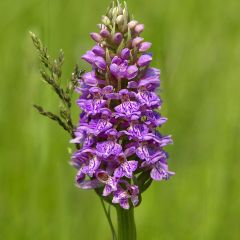
Dactylorhiza maculata - Spotted Orchi
- Flowering time June to August
- Height at maturity 50 cm
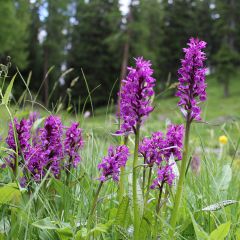
Dactylorhiza majalis - Marsh Orchid
- Flowering time June, July
- Height at maturity 30 cm
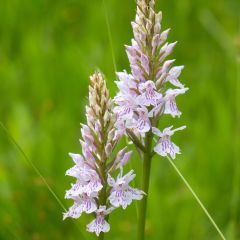
Dactylorhiza fuchsii - Common Spotted Orchi
- Flowering time June to August
- Height at maturity 45 cm
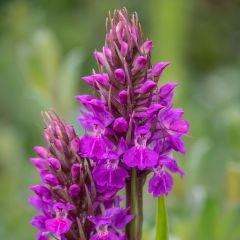
Dactylorhiza praetermissa - Marsh Orchid
- Flowering time June to August
- Height at maturity 50 cm
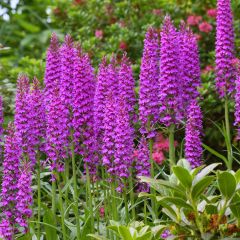
Dactylorhiza foliosa - Leafy Orchid
- Flowering time July, August
- Height at maturity 60 cm
Discover other Dactylorhiza
View all →Available in 1 sizes
Available in 1 sizes
Available in 1 sizes
Available in 1 sizes
Available in 1 sizes
Available in 1 sizes
Available in 1 sizes
Available in 1 sizes
Available in 1 sizes
Available in 1 sizes
Planting
Where to Plant?
Dactylorhiza thrive in full sun or partial shade. Generally, they will appreciate morning sun but prefer light shade during the hottest hours of the afternoon. As for the soil, it should be light and airy, not too compact. Dactylorhiza prefer fresh to moist soils with a slightly acidic pH (this is the case for Dactylorhiza maculata, D. praetermissa, D. purpurella, etc.), although this varies depending on the species: Dactylorhiza fuchsii, for example, grows in calcareous, well-draining, and rather dry soils.
In the garden, they can be grown in a rockery, a flowering meadow, at the edge of a flower bed, or in woodland for varieties that prefer shade. Some species grow naturally in mountainous areas, making them suitable for alpine rock gardens. Since Dactylorhiza generally prefer moist, even marshy soils, they are perfect for pond edges. For this situation, we particularly recommend Dactylorhiza praetermissa.
When to Plant?
We recommend planting Dactylorhiza in autumn, during September or October, or early in spring while the plant is still in dormancy.
How to Plant?
- Once you’ve chosen the ideal spot, dig a planting hole two to three times the size of the root ball.
- Mix the planting soil with 1/3 compost, 1/3 well-rotted compost, and 1/3 coarse sand for drainage. This is particularly important if you’re growing Dactylorhiza fuchsii. For acidophilous species, you can add some heather soil.
- Plant the Dactylorhiza, handling it carefully as its roots are fragile, and replace the potting substrate in the planting hole, as it contains the symbiotic fungus the Dactylorhiza needs to thrive. Place the Dactylorhiza in the centre of the hole, ensuring the collar is not buried.
- Fill in the hole with the substrate around the plant, then lightly firm the soil.
- Water generously.
- You can add a layer of organic mulch (dead leaves, straw, wood chips, etc.).
Continue watering in the weeks following planting until the plant is established.
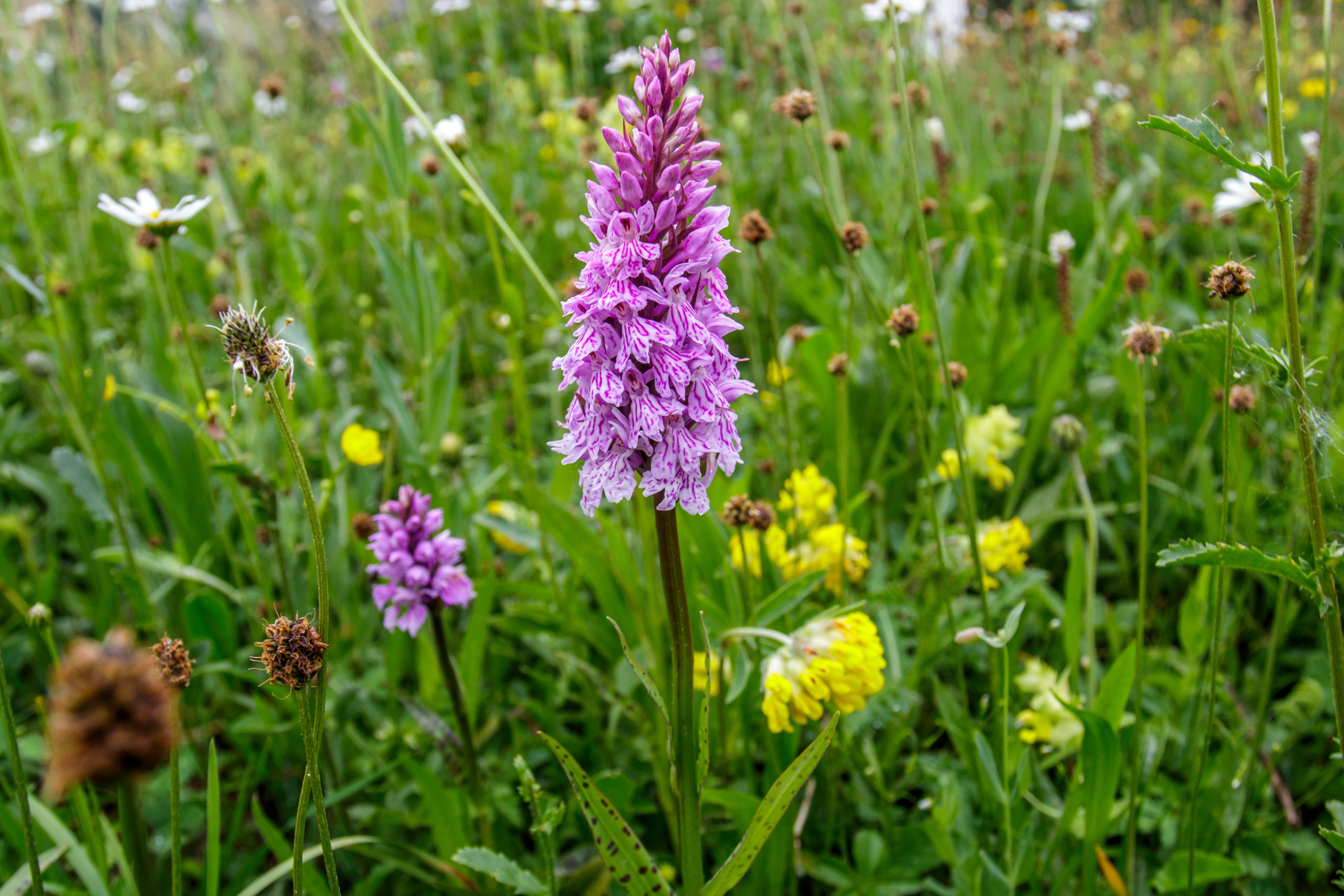
Dactylorhiza maculata
Maintenance
Most Dactylorhiza prefer fresh to moist soil. In spring and summer, if it doesn’t rain, you can water once or twice a week, allowing the soil to dry briefly between waterings. Preferably use rainwater, as tap water might be too calcareous for them. Don’t hesitate to add a layer of mulch; this will help keep the soil moist for longer while limiting the growth of weeds. In autumn and winter, when the plant is in dormancy, avoid watering, as excess moisture can cause the tubercles to rot.
After flowering, in mid to late summer, the foliage turns yellow and dries out. Wait until it is completely dry before cutting the flower stem and leaves.
Once established in the garden, Dactylorhiza dislikes being disturbed: if it thrives, avoid moving it.
Slugs and snails sometimes nibble on the leaves and young shoots. You can protect your Dactylorhiza by setting up a slug trap or using slug pellets. For more tips and information, check out our guide “Slugs: 7 Ways to Fight Them Effectively and Naturally”.
Multiplication
Dactylorhiza can be propagated by dividing clumps, as sowing (like with all orchids) is difficult to achieve and requires specific conditions, notably a symbiotic association with a fungus.
Dividing Clumps
Division should be carried out in late winter, around March, when the young plant is still in dormancy.
- Choose a clump of Dactylorhiza, then carefully dig it up, making sure to dig wide enough to avoid damaging the tubercles.
- Remove excess soil around the roots to expose them.
- Divide the clump into several sections, and remove any dead leaves or dried-out roots if you see any.
- Replant immediately, either in a pot or directly in the ground.
- Water generously.
Association
The delicate flowering of Dactylorhiza makes them easy to integrate into a naturalistic garden. Pair them with other light and airy blooms, such as those of the Lychnis flos-cuculi, columbines, and Sanguisorba menziesii, which produces small spikes of deep red-purple flowers resembling bottle brushes. You can also include the corydalis ‘Craigton Blue’, as well as other orchids like the Bletilla striata, which offers charming pink or white flowers depending on the variety. Among these stunning blooms, plant a few perennials with decorative foliage to bring a lush and very natural effect to the garden, such as hostas or ferns.
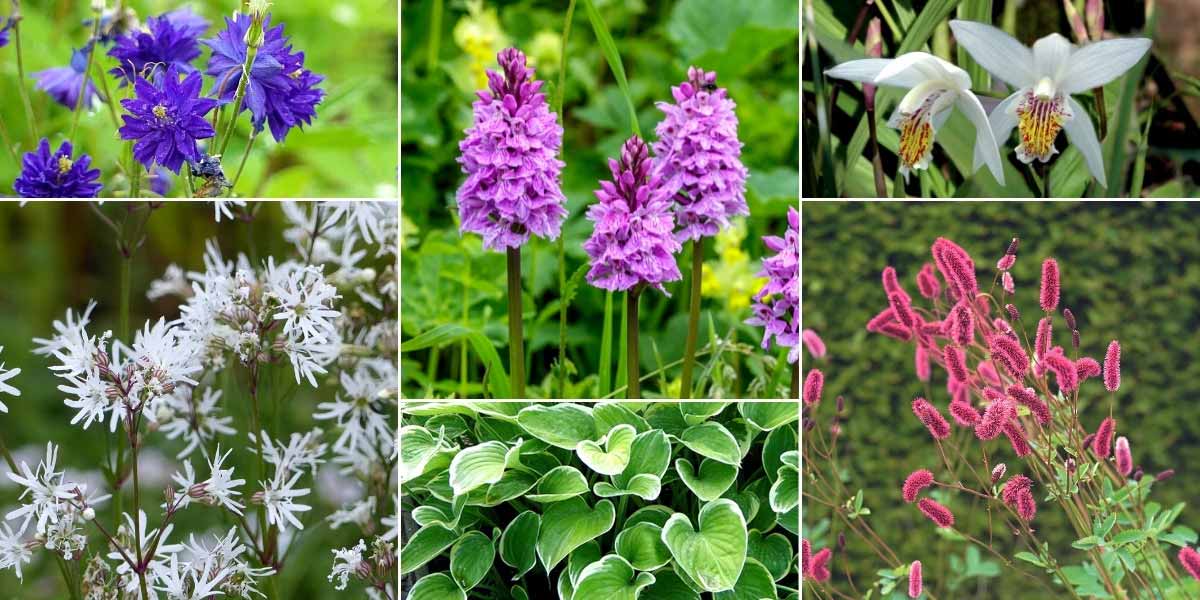
Aquilegia vulgaris ‘Blue Barlow’, Dactylorhiza maculata, Bletilla striata ‘Alba’, Lychnis flos-cuculi ‘White Robin’, Hosta ‘Clifford’s Forest Fire’, and Sanguisorba menziesii
On the banks of a pond, you can plant the Dactylorhiza praetermissa or the Dactylorhiza majalis alongside ferns such as the Matteuccia struthiopteris, Thelypteris palustris, or Osmundas. Also consider the generous foliage of reeds like Phragmites australis or the Phalaris arundinacea ‘Picta’, with its variegated foliage. For a touch of originality, opt for the undulate stems of Juncus effusus ‘Spiralis’. These plants will bring a lush and very natural green backdrop, perfectly highlighting the flowering of the orchids. Alongside them, plant Iris pseudacorus and globeflowers, with their bright spring blooms, marsh spurges, which flower in acid green, and Japanese primroses. Discover the splendid, very refined white flowering of the bogbean, Menyanthes trifoliata.
For more options, explore our full range of marginal perennials!
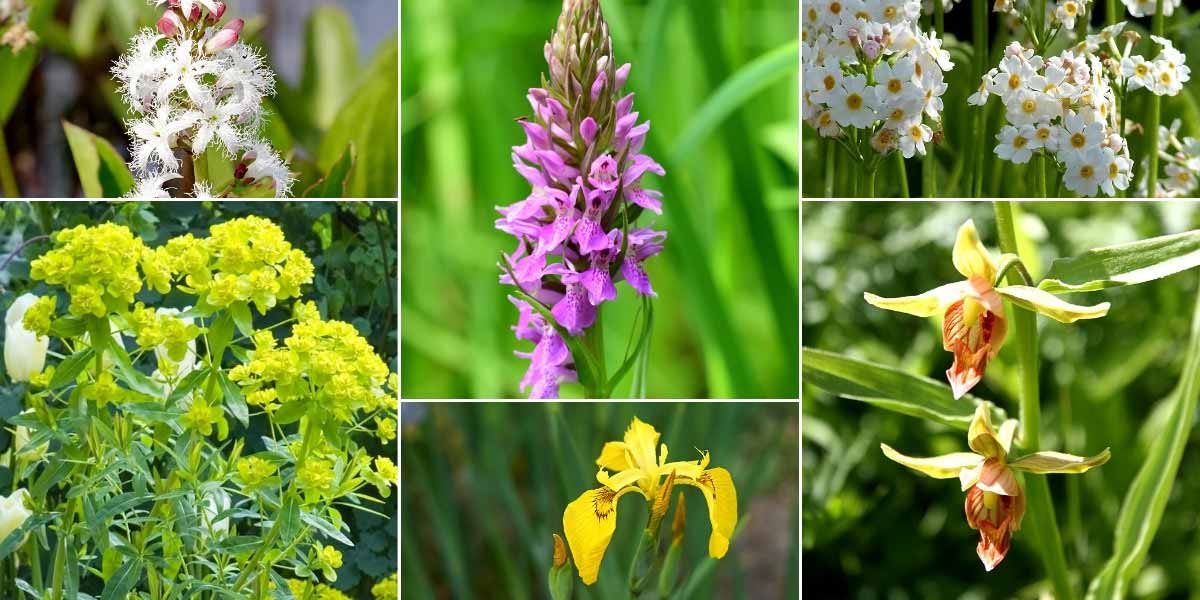
Menyanthes trifoliata, Dactylorhiza praetermissa, Primula japonica ‘Alba’, Euphorbia palustris ‘Walenburg’s Glory’, Iris pseudacorus, and Epipactis gigantea
Useful resources
-
- Discover our range of Dactylorhiza and our entire range of garden orchids
- Our complete guide: « Garden Orchids: Planting, Growing and Caring »
- Feel free to check out Olivier’s article: « Hardy Orchids to Grow in the Garden »
- Subscribe!
- Contents



































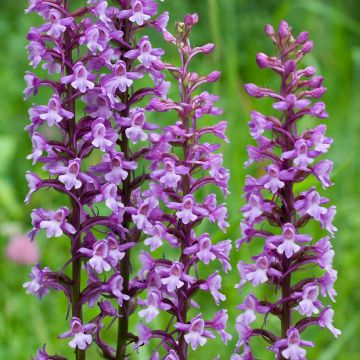
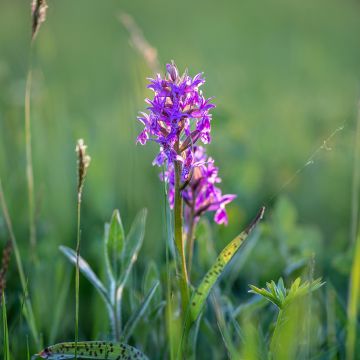
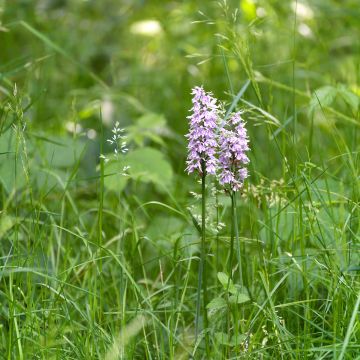


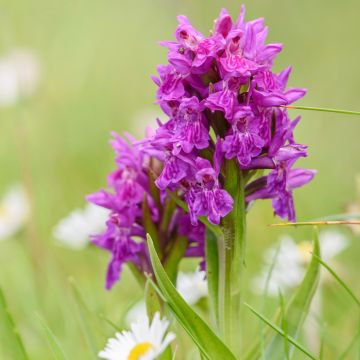
Comments